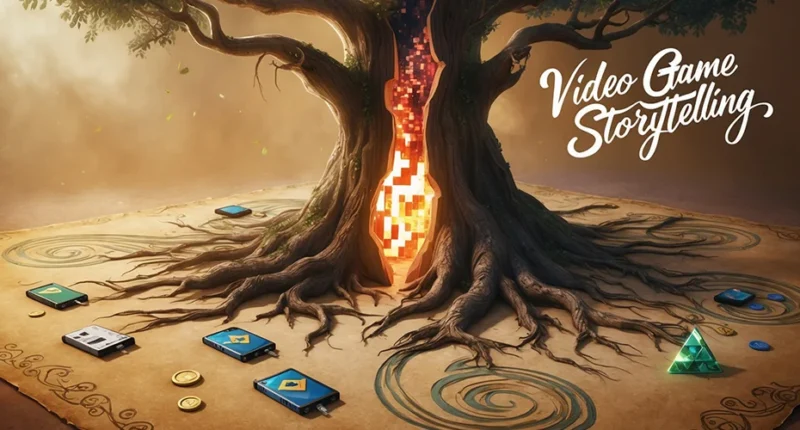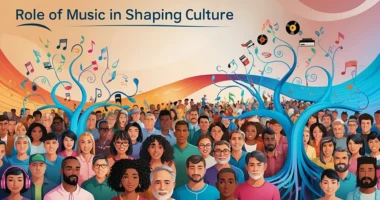Table of Contents
- Early Days: Simple Plots and Basic Narratives
- The 90s: The Rise of Characters and Narrative Depth
- The 2000s: More Immersive Worlds and Choices
- The 2010s: Cinematic Experiences and Emotional Impact
- The 2020s: Open Worlds, Interactive Narratives, and Diversity
- The Future: AI, Virtual Reality, and More
- Conclusion
Video games have come a long way since their early days, with storytelling playing a huge role in how players experience games. From simple narratives with basic plots to complex, cinematic tales that rival movies and TV shows, video game storytelling has evolved significantly. Let’s take a look at how storytelling in video games has changed over time and why it has become such a vital part of gaming today.
Early Days: Simple Plots and Basic Narratives
In the early days of video games, storytelling was minimal. Games like Pac-Man and Space Invaders didn’t have much of a plot. The focus was mainly on gameplay—getting the highest score or completing levels. If there was a story, it was usually simple and served as background context, such as rescuing a princess or defeating an alien invasion. These early games didn’t need complex stories because the gameplay itself was enough to keep players engaged.
At this time, technology was limited, and developers couldn’t include long, detailed narratives. Instead, they focused on gameplay mechanics and making the experience fun. Still, even with these basic stories, players started to get a sense of excitement and adventure from their gaming experience.
The 90s: The Rise of Characters and Narrative Depth
As technology improved, so did the ability to tell more detailed stories. In the 1990s, games like Final Fantasy VII, The Legend of Zelda: Ocarina of Time, and Super Mario 64 started introducing deeper characters and more complex plots. This era marked the beginning of what we think of as modern video game storytelling, where players became more emotionally invested in the characters and their journeys.
Games from this time started to include cinematic cutscenes, voice acting, and intricate dialogue, which brought the characters and their world to life. The focus was still on the gameplay, but the story began to add more layers to the experience, making players care about the characters’ struggles, dreams, and achievements.
The 2000s: More Immersive Worlds and Choices
By the early 2000s, video games had begun to create immersive worlds with rich stories that players could explore at their own pace. The Elder Scrolls III: Morrowind, Grand Theft Auto III, and Halo helped take storytelling to new heights by allowing players to interact with the game world in ways that were never seen before.
In these games, players were no longer just following a linear story. They could make choices that affected the outcome of the game, shaping the narrative based on their actions. This level of interactivity gave players a sense of agency, making them feel like they were part of the story rather than just observers. Games like The Sims and Mass Effect introduced branching storylines, where the choices you made in the game could lead to different endings, allowing for a more personalized experience.
The 2010s: Cinematic Experiences and Emotional Impact
As video games entered the 2010s, they started to resemble movies in terms of storytelling. Games like The Last of Us, Red Dead Redemption 2, and God of War took storytelling to a new level by focusing on rich, emotional narratives that rivaled anything in cinema. These games used high-quality graphics, motion capture technology, and professional voice acting to create lifelike characters and immersive environments.
The stories told in these games were often complex and mature, dealing with themes like loss, love, revenge, and redemption. Players could get lost in these stories, forming deep connections with the characters and feeling the emotional weight of their decisions. The ability to tell such powerful stories helped elevate video games as a legitimate form of entertainment, allowing them to be recognized for their narrative depth as much as their gameplay.
The 2020s: Open Worlds, Interactive Narratives, and Diversity
In the current era, video game storytelling has become even more expansive, with open-world games like The Witcher 3: Wild Hunt and Cyberpunk 2077 offering players massive worlds to explore, full of rich characters and complex plots. These games give players the freedom to roam vast landscapes, take on side quests, and build relationships with characters, all while advancing the main story.
The 2020s have also seen an increase in diverse representation in video game storytelling. Games like The Last of Us Part II and Life is Strange tackle important social issues such as LGBTQ+ rights, mental health, and racial inequality. This shift reflects a broader trend of inclusivity and diversity in the gaming industry, with developers aiming to create stories that resonate with a wider audience.
At the same time, interactive storytelling has continued to evolve. Games like Detroit: Become Human and Tales from the Borderlands offer players a more hands-on approach to storytelling, allowing them to make choices that have real consequences on the narrative. These types of games blur the line between video games and movies, creating an experience where players feel like they are writing their own story.
The Future: AI, Virtual Reality, and More
Looking ahead, the future of video game storytelling is incredibly exciting. With advancements in AI and virtual reality (VR), the next generation of video games may allow players to interact with characters in even more lifelike ways. Imagine a game where the characters respond to your actions in real-time, learning from your decisions and adapting the story as it unfolds. Virtual reality could take this a step further by immersing players in the story, making them feel like they are truly part of the world they are exploring.
As storytelling in games continues to evolve, we can expect even more innovative experiences that push the boundaries of what’s possible. Whether through AI-driven narratives, VR worlds, or new forms of interactive storytelling, the future of video game narratives promises to be just as dynamic and thrilling as the games themselves.
Conclusion
The evolution of video game storytelling has been a fascinating journey. What started as simple plots and limited narratives has transformed into rich, immersive stories that rival movies and books. From the early days of basic gameplay to the emotional, cinematic experiences of today, video games have become a powerful medium for storytelling. With advancements in technology, the future of video game narratives is looking brighter than ever, offering players even more ways to experience the magic of storytelling in their favorite games.










